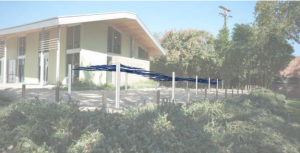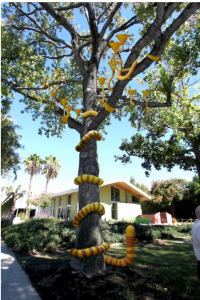
The City of West Hollywood has commissioned works by Miki Iwasaki and Tim Murdoch for “Can You Dig It?”, its upcoming temporary land art exhibition, which was conceived to address the current California drought.
“Can You Dig It?” is part of Art on the Outside, West Hollywood’s public art program that installs rotating temporary artworks on medians and in parks. A request for submissions was issued mid-summer, and the city received applications from 61 artists and artist teams from eight states nationwide. Finalists were reviewed by the Arts and Cultural Affairs Commission in early November. The two works chosen will be installed in Plummer Park early next year.
Artist, designer and architect Miki Iwasaki’s “Aqueous Skin” is a suspended canopy composed of recycled and repurposed metal remnants arranged to resemble the surface of water.
Functionally, the artwork provides shade, at the same time that it encourages viewers to make associations with a dynamic range of issues relevant to local and universal ideas about water and the environment. In addition to provoking thought about the drought, Iwasaki’s piece references Los Angeles’ ongoing affinity for mid-century modern style in its design and detailing, as well as car culture through the use of salvaged automotive parts. Aqueous Skin will be installed in from of the Plummer Park Community Center in late January, 2016.

The title of Tim Murdoch’s “And The Tree Was Happy”—a whimsical vine of colorful, segmented plastic tubes ascending a tree—references Shel Silverstein’s book “The Giving Tree.” Dr. Seuss’s “The Lorax” is also a source of inspiration, another classic in which a serious tale is told in a humorous and approachable way.
Made completely from salvaged materials dramatically in contrast with nature, “And The Tree Was Happy” winds up to the tree’s lower branches, culminating in blossom-like water catchers. At the tree’s base sits a bulbous knob containing a faucet to access the water. The valve represents an opportunity at redemption, our redemption, says the artist—“We could choose to take the water and use it for ourselves, or we could choose to return the water to the tree.” The project will be installed in the center of Plummer Park in late Februar 2016.
Land Art, Earthworks or Earth Art—the inspirations for “Can You Dig It?”—refer to an influential art movement that emerged in the U.S. in the late 1960s and early 1970s in which landscape and the work of art are seamlessly linked. The artworks frequently exist in the open, left to change and erode under natural environmental conditions (Jeffrey Kastner, Land and Environmental Art, survey by Brian Wallis. Phaidon Press. 2010).
Examples of notable land art projects include: Andy Goldsworthy, Woven Branch Arch; Maya Lin, The Wave Field; Nancy Holt, Sun Tunnels; Michael Heizer, Double Negative; Buster Simpson, The Hudson Headwaters Purge; Christo and Jean Claude, Surrounded Islands. A new documentary feature, Troublemakers: The Story of Land Art – A Film By James Crump (2015), explores the movement.
Additional projects are under consideration for “Can You Dig It?” A public reception will be held in the New Year, date to be announced. For more details: http://www.weho.org/residents/arts-and-culture/visual-arts/art-on-the-outside/can-you-dig-it

Lynn, I couldn’t agree more. The caliber of artists being allowed to put up their art in Weho is very hit or miss. I am so sick of the ‘illuminated sculpture’ that looks like a Wells Fargo ATM that’s in the middle of the street. When they blocked traffic to put those in I swear they said it was only going to be up until July and it’s still there now
To get back on subject, perhaps we need folks of the caliber of Noah Purifoy currently exhibited at BCAM. His concepts of activism art would be welcome from a new generation of artists that go far beyond the superficial. They are out there. ARTBOUND continues to present environmentally sensitive artists and their work. It’s worth considering.
We have a very serious housing crisis. Art needs to take a back seat to more important and pressing issues.
How about a “Homeless Fund” that developers should be required to pay into. If we can build affordable housing we can build a multi purpose center to help these folks restart their lives. If it is located in the city center, the previously abandoned Walgreen’s project at Santaonica Blvd and Crescent Heights, every eye will be on it. There are currently third generation homeless folks living on our the streets. We are small enough, financially stable and flexible enough to put solutions to work here and now creating a model for other communities to follow. Isn’t that what WeHo is… Read more »
does anyone know how many meals could be prepared for the desperately homeless with $20,000. ?
or perhaps, money for reuniting the homeless with family ?
I like these projects and support them. They are a relative bargain at $12,000 to help bring awareness to the drought. Current:LA is funded at $20,000 per project which is a lot more obviously and this money isn’t the people’s taxes anyway. It’s from a percent for art fund that developers pay into and there’s enough of a reserve that the city is planning on doubling the number of artworks in this program! More art!
the answer is no, i can’t and won’t ‘dig it’.
what a waste of someone’s money, probably taxpayers. as for the waste of these ‘artist’s time, that’s their problem.
when the city can’t, or won’t address real problems that affect people in a serious way, you pander to the ‘hug me’ crowd and offer this artistic self gratification.
it’s pathetic and pointless.
i’m glad this article is presented by wehoville unnamed staff, and didn’t have to specifically embarrass whoever tore this press release from the transom and posted it online.
Great satire! I almost thought this was real!
Mother Nature likes simplicity. In simplicity is beauty. It is up to us to respect that and work in harmony to achieve balance. Everything else seems excessive.
Can we put this much effort and money into solving the homeless issue around town, — we can’t just throw money at PATH and say we did our best.. All the best art around the city won’t cover up the sights and smells of the homeless on our streets.
Every year the New York Times does a series on its Neediest Cases. Perhaps we could immediately identify these folks in our town and get help immediately. Last Thursday I met John, a gentleman that lives next to the bus shelter on Fairfax & Willoughby. I inquired of Patrick @ Ok dog on the opposite corner as to his circumstances. I learned of his arduous path after serving his country in Vietnam. It started to rain, and I then observed John had moved into the bus shelter under his pile of yurt=like blankets sitting next to someone waiting for the… Read more »